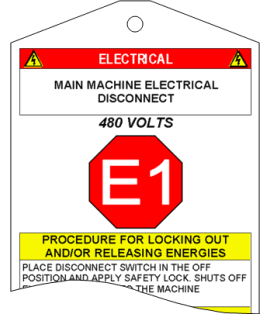Home » Lockout Resources » Energy Source Reference » Electrical Energy Sources
Electrical Energy Sources

Definition of Electrical Energy
Electrical energy is a type of kinetic energy that can be described as the flow of power or charges along a conductor. Most industrial equipment subject to OSHA 1910.147 will have at least one electrical Energy Source. To do useful work, industrial equipment often converts electrical energy into other forms of kinetic or Potential Energy.
Associated Electrical Energy Hazards
Per OSHA, there are hundreds of deaths annually due to improper handling of electrical energy. Direct hazards vary from mild electrical shock, all the way to arc flash, and arc blast.
Injuries associated with electrical energy generally consist of four main types as follows:
- electrocution (fatal)
- electric shock impeding heart function or breathing due to loss of muscle control
- burns causing damage to the skin or internal organs
- falls and disorientation caused as a result of contact with electrical energy
Use of proper PPE and insulated tools greatly reduces the risk of injury due to contact with electrical energy. Proper Lockout/Tagout can virtually eliminate the risk of contact with electrical energy.
Means of Electrical Energy Isolation
Electrical energy must be controlled via a mechanical energy isolating device that physically prevents the transmission or release of energy. The use of control logic such as emergency stop buttons or gate interlocks is not an acceptable form of energy isolation.
Verifying Absence of Electrical Energy
Verifying the absence of electrical energy after performing Lockout/Tagout can be done by attempting to operate the associated components and by observing the associated indicators. It is also a good practice to use a voltmeter and verify that there is no power by observing zero voltage in the associated circuits.
NOTE: When using a voltmeter, always approach the task as if the circuit was Energized.
Typical Electrical Energy Isolation Devices
Electrical energy isolation devices may vary in design and configuration. The most common types are:
Typical Electrical Energy Lockout Devices
Electrical energy Lockout devices use positive means such as a lock and key to keep the associated energy isolation device in the safe (disconnected) position and prevent equipment energization. Typical electrical energy lockout devices are outlined in the Electrical page.
Lockout Services | Turnkey Programs | Lockout Procedures | Single-Source Procedures | Basic Procedures | Standard Procedures | Advanced Procedures | Custom Procedures | Energy Control Tags | Alternative Protective Measures | Minor Servicing Exception | Online Services | Lockout Audits | Corporate Standards | Lockout Training | Reference Guides | Services RFQ | DEenergizer | Lockout Devices | Electrical | Valve and Pneumatic | Accessories | Group Lockout/Tagout | Devices Index | Devices RFQ | Lockout Resources | OSHA Documentation | NIOSH Documentation | White Papers and Articles | Lockout/Tagout FAQ | Lockout/Tagout News | Lockout/Tagout Signs | Energy Source Reference | Training Material | Library | Glossary | Sitemap | About | Contact Information | Careers | Privacy Policy | Terms of Use | Legal Notice

